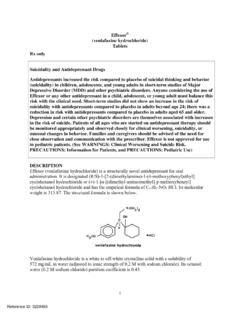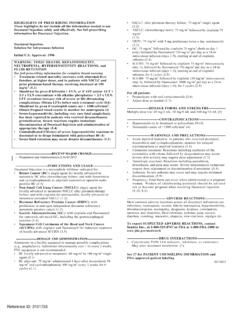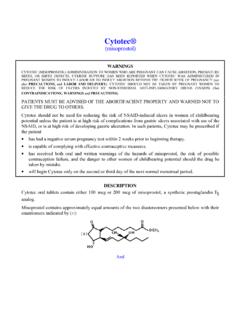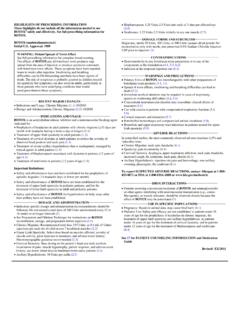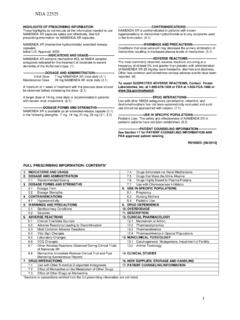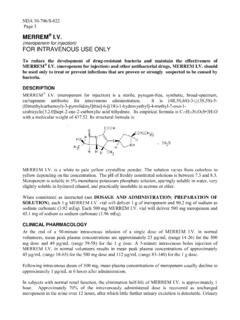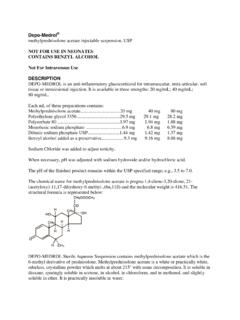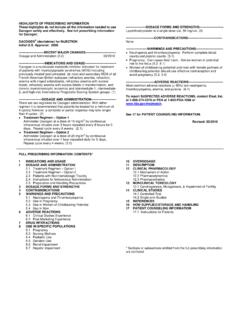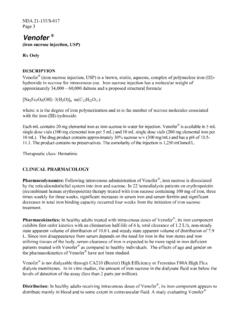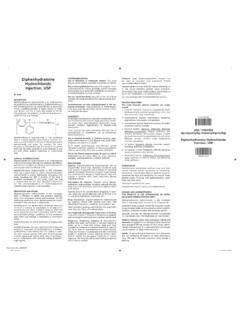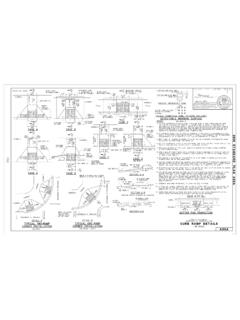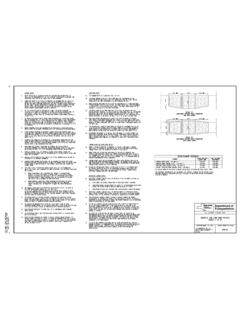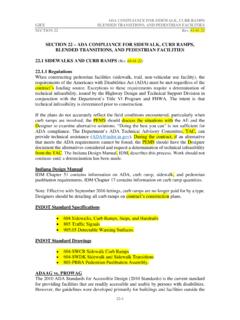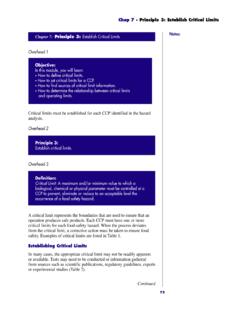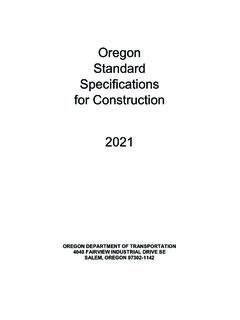Transcription of Focalin™ XR - Food and Drug Administration
1 focalin xr (dexmethylphenidate hydrochloride) extended-release capsules Rx only Prescribing Information DESCRIPTION focalin xr (dexmethylphenidate hydrochloride) extended-release capsules is an extended-release formulation of dexmethylphenidate with a bi-modal release profile. focalin xr uses the proprietary SODAS (Spheroidal Oral drug Absorption System) technology. Each bead-filled focalin xr capsule contains half the dose as immediate-release beads and half as enteric-coated, delayed-release beads, thus providing an immediate release of dexmethylphenidate and a second delayed release of dexmethylphenidate. focalin xr 5, 10, and 20 mg capsules provide in a single dose the same amount of dexmethylphenidate as dosages of , 5, or 10 mg of Focalin tablets given Dexmethylphenidate hydrochloride, the d-threo enantiomer of racemic methylphenidate hydrochloride, is a central nervous system (CNS) stimulant.
2 Dexmethylphenidate hydrochloride is methyl -phenyl-2-piperidineacetate hydrochloride, (R,R )-(+)-. Its empirical formula is C14H19NO2 HCl. Its molecular weight is and its structural formula is Note: * = asymmetric carbon centers Dexmethylphenidate hydrochloride is a white to off white powder. Its solutions are acid to litmus. It is freely soluble in water and in methanol, soluble in alcohol, and slightly soluble in chloroform and in acetone. focalin xr also contains the following inert ingredients: ammonio methacrylate copolymer, FD&C Blue #2 (5mg strength), FDA/E172 Yellow Iron Oxide (10mg strength), gelatin, ink Tan SW-8010, methacrylic acid copolymer, polyethylene glycol, sugar spheres, talc, titanium dioxide, and triethyl citrate.
3 CLINICAL PHARMACOLOGY Pharmacodynamics Dexmethylphenidate hydrochloride, the active ingredient in focalin xr , is a central nervous system stimulant. Dexmethylphenidate, the more pharmacologically active d-enantiomer of racemic methylphenidate, is thought to block the reuptake of norepinephrine and dopamine into the presynaptic neuron and increase the release of these monoamines into the extraneuronal space. The mode of therapeutic action in Attention Deficit Hyperactivity Disorder (ADHD) is not known. Pharmacokinetics Absorption focalin xr produces a bi-modal plasma concentration-time profile ( , two distinct peaks approximately four hours apart) when orally administered to healthy adults. The initial rate of absorption for focalin xr is similar to that of Focalin tablets as shown by the similar rate parameters between the two formulations, , first peak concentration (Cmax1), and time to the first peak (tmax1), which is reached in 1 hours (typical range 1-4 hours).
4 The mean time to the interpeak minimum (tminip) is slightly shorter, and time to the second peak (tmax2) is slightly longer for focalin xr given once daily (about hours, range hours) compared to Focalin tablets given in two doses 4 hours apart (see Figure 1), although the ranges observed are greater for focalin xr . focalin xr given once daily exhibits a lower second peak concentration (Cmax2), higher interpeak minimum concentrations (Cminip), and less peak and trough fluctuations than Focalin tablets given in two doses given 4 hours apart. This is due to an earlier onset and more prolonged absorption from the delayed-release beads (see Figure 1). The AUC (exposure) after Administration of focalin xr given once daily is equivalent to the same total dose of Focalin tablets given in two doses 4 hours apart.
5 The variability in Cmax, Cmin, and AUC is similar between focalin xr and Focalin IR with approximately a three fold range in each. Radiolabeled racemic methylphenidate is well absorbed after oral Administration with approximately 90% of the radioactivity recovered in urine. However, due to first pass metabolism the mean absolute bioavailability of dexmethylphenidate is when administered in various formulations was 22-25%. Figure 1 Mean dexmethylphenidate plasma concentration-time profiles after Administration of 1 x 20 mg focalin xr (n=24) capsules and 2 x 10 mg Focalin immediate release tablets (n=25) time [h]0 4 8 12162024dexmethylphenidate conc.[ng/mL]05101520 focalin xr 20 mgFocalin IR 2 x 10 mg Dose Proportionality Dose proportionality of focalin xr was evaluated in a randomized single-dose five-period cross-over study with Administration of single doses of 5, 10, 20, 30 and 40 mg to healthy adults.
6 Results confirmed dose-proportionality within this dose range. food Effects Administration times relative to meals and meal composition may need to be individually titrated. No food effect study was performed with focalin xr . However, the effect of food has been studied in adults with racemic methylphenidate in the same type of extended-release formulation. The findings of that study are considered applicable to focalin xr . After a high fat breakfast, there was a longer lag time until absorption began and variable delays in the time until the first peak concentration, the time until the interpeak minimum , and the time until the second peak. The first peak concentration and the extent of absorption were unchanged after food relative to the fasting state, although the second peak was approximately 25% lower.
7 The effect of a high fat lunch was not examined. There is no evidence of dose dumping in the presence or absence of food . There were no differences in the plasma concentration-time profile, when administered with applesauce, compared to Administration in the fasting condition. The results are expected not to differ for focalin xr . For patients unable to swallow the capsule, the contents may be sprinkled on applesauce and administered (see DOSAGE AND Administration ). Distribution The plasma protein binding of dexmethylphenidate is not known; racemic methylphenidate is bound to plasma proteins by 12-15 %, independent of concentration. Dexmethylphenidate shows a volume of distribution of L/kg. Plasma dexmethylphenidate concentrations decline monophasically following oral Administration of focalin xr .
8 Metabolism and Excretion In humans, dexmethylphenidate is metabolized primarily to d- -phenyl-piperidine acetic acid (also known as d-ritalinic acid) by de-esterification. This metabolite has little or no pharmacological activity. There is no in vivo interconversion to the l-threo-enantiomer, based on a finding of no levels of l-threo-methylphenidate being detectable after Administration of up to 40 mg dexmethylphenidate in adults. After oral dosing of radiolabeled racemic methylphenidate in humans, about 90% of the radioactivity was recovered in urine. The main urinary metabolite of racemic (d,l-) methylphenidate was d,l-ritalinic acid, accountable for approximately 80% of the dose. Urinary excretion of parent compound accounted for % of an intravenous dose.
9 In vitro studies showed that dexmethylphenidate did not inhibit cytochrome P450 isoenzymes at concentrations observed after therapeutic doses. Intravenous dexmethylphenidate was eliminated with a mean clearance of corresponding to L/min. The mean terminal elimination half-life of dexmethylphenidate was just over 3 hours in healthy adults and typically varied between 2 and hours with an occasional subject exhibiting a terminal half-life between 5 and 7 hours. Children tend to have slightly shorter half-lives with means of 2 3 hours. Special Populations Gender After Administration of focalin xr the first peak, (Cmax1), was on average 45% higher in women. The inter-peak minimum and the second peak also tended to be slightly higher in women although the difference was not statistically significant, and these patterns remained even after weight normalization.
10 Pharmacokinetic parameters for dexmethylphenidate after Focalin immediate release tablets were similar for boys and girls. Race There is insufficient experience with the use of focalin xr to detect ethnic variations in pharmacokinetics. Age The pharmacokinetics of dexmethylphenidate after focalin xr Administration have not been studied in children less than 18 years of age. When a similar formulation of racemic methylphenidate was examined in 15 children between 10 and 12 years of age and 3 children with ADHD between 7 and 9 years of age, the time to the first peak was similar, although the time until the between peak minimum , and the time until the second peak were delayed and more variable in children compared to adults. After Administration of the same dose to children and adults, concentrations in children were approximately twice the concentrations observed in adults.
